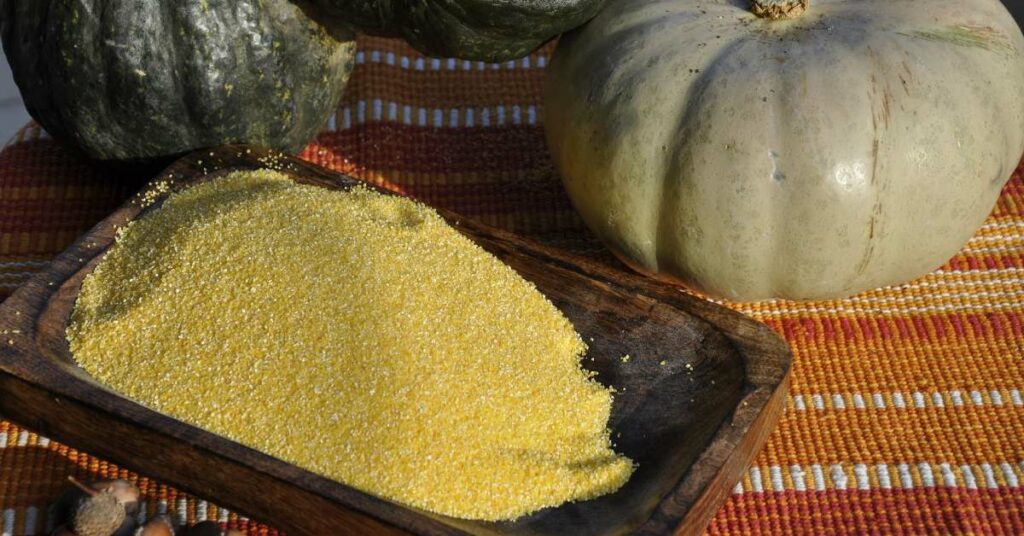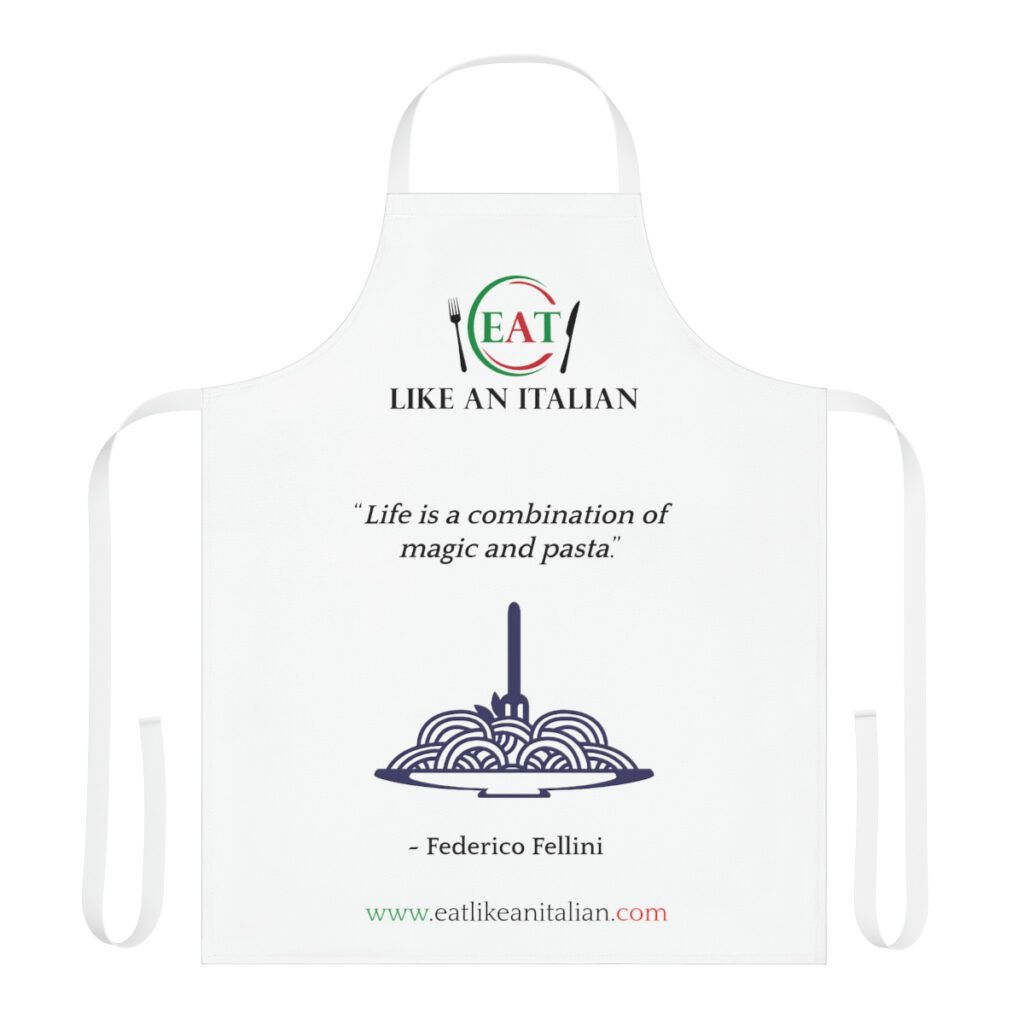Polenta is a traditional Italian dish that is made from coarsely ground cornmeal. It originated in Northern Italy, specifically in the regions of Lombardy, Veneto, and Friuli-Venezia Giulia, where it has been a staple food for centuries, traditionally associated with lower classes.
Traditionally, polenta is made by slowly cooking the cornmeal in boiling water or broth until it forms a thick and creamy porridge-like consistency. This process can take anywhere from 45 minutes to several hours, depending on the type of cornmeal used and the desired texture.
Polenta can be served soft and creamy, or cooled and sliced into rounds or squares, which are then grilled, fried, or baked. It is a versatile dish that can be flavored with various ingredients such as cheese, butter, garlic, herbs, and spices. It would not be entirely wrong to think of polenta as a “substitute” for pasta.
As such, polenta can be used as a base for toppings such as sautéed mushrooms, grilled vegetables, or tomato sauce. In many regions of Italy, polenta is eaten as a main dish, with the addition of ingredients such as sausage, beans, or cheese. Sometimes polenta is served as a side dish to accompany meats, stews, and sauces.
Polenta has cultural significance in Italian cuisine and is a symbol of regional identity in Northern Italy. It is often associated with peasant cuisine and is a traditional food served during holidays and special occasions.
Today, polenta has become a popular dish not only in Italy but also in many other parts of the world, and its versatility and simplicity continue to make it a favorite among home cooks and professional chefs alike.

How to Make Polenta
To make polenta, the main ingredient needed is cornmeal, which is typically made from dried and ground corn. There are several types of cornmeal that can be used, each with its own texture and flavor profile. The most common types of cornmeal used for making polenta are:
- Yellow Cornmeal: This is the most common type of cornmeal used in making polenta. It has a coarse texture and a slightly sweet and nutty flavor.
- White Cornmeal: This type of cornmeal is milder in flavor and has a finer texture than yellow cornmeal.
- Instant Cornmeal: This type of cornmeal is precooked and ground, making it quick and easy to prepare. However, it may lack the traditional flavor and texture of polenta made from whole grain cornmeal.
To prepare polenta, the cornmeal is typically combined with water or broth and slowly cooked over low heat, stirring constantly to prevent lumps from forming. The traditional ratio of cornmeal to liquid is 1:4, but this can vary depending on the desired consistency.
While a regular pot can be used to make polenta, some traditional Italian households use a special pot called a “paiolo” or “polenta pot.” This is typically made of copper and has a wide bottom to allow for even cooking and stirring.
Other kitchen tools used for making polenta include a wooden spoon or spatula for stirring and a whisk for breaking up any lumps. And of course, don’t forget to wear an apron!
Polenta can also be prepared in a pressure cooker, slow cooker, or even baked in the oven. Some modern variations of polenta incorporate ingredients such as milk, cream, butter, cheese, or herbs and spices to enhance the flavor and texture.

Kitchen Apron
Let the home cook shine in the kitchen with a touch of character, the personalized chef’s apron. This apron comes with a tie-back closure to fit securely, a sewn-in care label for guesswork-free maintenance, and a highly durable 100% polyester canvas construction for top-tier durability. Comes with black, beige, blue, pink, or white strap color, and in one size: 31.5″ x 25.6″.
.: Mater…
Overall, the preparation of polenta requires patience and attention to detail to achieve the desired creamy and smooth consistency.
What to Serve with Polenta
Polenta can be served in various ways, depending on the region and the occasion. Traditionally, in Northern Italy, polenta is often served as a side dish to accompany hearty meat dishes, stews, or sausages. For instance, it pairs well with Osso Buco, a slow-cooked veal shank stew, or Brasato, a beef pot roast. Polenta can also be served alongside grilled or roasted meats, such as lamb, pork, or beef.

In addition to meat dishes, polenta can also be served with Italian vegetarian ingredients and vegan options. For example, it can be paired with sautéed mushrooms, grilled vegetables, or a tomato-based sauce. It is a popular dish among vegetarians and vegans because it is naturally gluten-free and can be easily adapted to a plant-based diet.
Cheese is another popular pairing with polenta, and some of the classic cheeses that go well with polenta include Parmigiano-Reggiano, Gorgonzola, and Taleggio. These cheeses can be incorporated into the polenta during the cooking process or served on top as a garnish.
Wine Pairing with Polenta
When it comes to wine pairings, the general rule of thumb is to pair lighter-bodied wines with lighter dishes and heavier-bodied wines with heartier dishes. With polenta, a lighter-bodied red wine such as Chianti or Valpolicella pairs well with vegetarian options, while a fuller-bodied wine such as Barolo or Amarone goes well with meat-based dishes.
Is Polenta Nutritious?
Polenta is a nutritious food that offers a variety of health benefits. As a whole grain, it is a good source of complex carbohydrates, which are essential for providing energy and maintaining blood sugar levels. Polenta is also high in dietary fiber, which can help to promote digestion and support overall gut health. In addition, it contains several essential vitamins and minerals, including vitamin A, vitamin B-6, iron, and magnesium.
One cup of cooked polenta (about 160 grams) contains approximately:
- 145 calories
- 1.5 grams of fat
- 31 grams of carbohydrates
- 2 grams of fiber
- 3 grams of protein
- 15% of the daily recommended intake of iron
- 18% of the daily recommended intake of magnesium
- 10% of the daily recommended intake of vitamin A
- 5% of the daily recommended intake of vitamin B-6
Polenta is also gluten-free, making it a good option for individuals with celiac disease.
The high fiber content in polenta can help to reduce the risk of heart disease by lowering cholesterol levels and promoting overall cardiovascular health. In addition, the magnesium content in polenta can help to regulate blood pressure and improve insulin sensitivity, making it a good food for individuals with diabetes or pre-diabetes.
Polenta is a healthy and nutritious food that offers a range of health benefits. It is a good source of complex carbohydrates, fiber, and essential vitamins and minerals, making it a valuable addition to a well-balanced diet.
What is Polenta? – FAQs
How is polenta normally served?
Polenta can be served immediately as a hot porridge, or it can be allowed to cool and then sliced and fried or grilled.
Is polenta the same as grits?
Polenta and grits are similar in that they are both made from cornmeal, but they are not the same. Polenta is an Italian dish made from yellow or white cornmeal, while grits are a Southern American dish made from white cornmeal. The two dishes have different textures, with polenta being more coarse and grits being more finely ground.
Is polenta gluten-free?
Yes, polenta is naturally gluten-free as it is made from cornmeal.
Is polenta kosher?
Polenta is generally considered kosher, as it is made from cornmeal and does not contain any non-kosher ingredients. However, it is important to note that some brands of polenta may be processed on equipment that is also used for non-kosher products, which may impact their kosher status. Therefore, it is always important to check the packaging for kosher certification to ensure that it meets your dietary needs.
